Dave Lyall joins us on Racing Routes with Hamm at 7pm Monday 6-13-2022. Dave was Jack Roush’s 48th employee at Roush Performance Engineering in the 1960’s as well as a standout in Drag Racing. Dave was a pioneer in Pro Stock racing. NASCAR was the first to sanction Pro Stock type of drag racing, which was picked up by the now defunct AHRA. In June of 1969 in Bristol Tennessee, Dave was the first Pro Stock to dip into the 9’s. On this Episode you’ll hear stories about how some of the NASCAR regulars would also drag race at the Deland Airport the evening before the Daytona 500 and Richard Petty Team’s brief involvement in the sport.
Right about that time Ford’s then drag racing manager Emil Loeffler introduced Dave Lyall to Carl Holbrook, another up and coming drag racer from New Jersey. That was the beginning of a long relationship that lead to Dave and Carl even becoming related when Dave married Carl’s wife’s sister. Dave left Ford in 1970 to open his own Garage. The business was doing well, but Ford kept approaching Dave to come back. In 1977, Dave went back to work at Ford. There were still projects that Dave hadn’t finished at his old shop.
Carl provided Dave a place in his shop to set up and finish the projects from the old shop. Dave was working at Ford during the day and at Holbook’s at night. During that time Dave started influencing a new generation of racer fabricators. In 1982, Chris Holbrook had just started working at the shop along with a 16 year old Steve Grebeck. Chris Holbrook and Steve Grebeck served their apprenticeship together under the supervision of Carl Holbrook during the day and Dave Lyall at night. The group was working on Holbrook’s Pro Stock and Super Stock teams during the day, and then Dave would work with Steve fabricating at night.
It wasn’t long before Jack Roush wanted Dave to quit Ford and come work for him. The deal contained a clause that kept Dave from working for anyone else while he worked for Jack. Steve followed Dave to Roush’s shop where they worked on every racing program Jack Roush was involved in. The programs that Dave worked on at Roush Industries for the next 17 years expanded Dave’s already large knowledge base. Below is Dave Lyall’s story as told by him, enjoy and thanks for visiting Racing Routes, David Hamm.
1953 to 1955: At age 13, I hung around and then worked for Campbell’s Gulf Service, a local full-service gas station in East Detroit, (now called Eastpointe) a business which raced a “Hardtop” (Modified, mostly prewar Fords) at Motor City Speedway, our local short track. I washed parts, knocked out dents, washed the race car and helped load the tools and equipment on race days. When there was room for me, I rode along to the track, and if not, I hitch-hiked and walked the 2 ½ miles to the track. The Campbell’s (two generations) began treating me like one of the family, and gave me the run of the place. It was a full service gas station, offering complete repairs on any part of the vehicle, and for its day was a well equipped shop. They also had both the AAA and the local Police Towing contract. By the time I was 16, I had taught myself to weld, to be a mechanic, to drive a wrecker (this was before the Jaws of Life, so we used the wreckers to rescue trapped occupants by pulling the wrecked vehicles apart) and had already acquired a life-long fascination of all things mechanical and a love of auto racing.
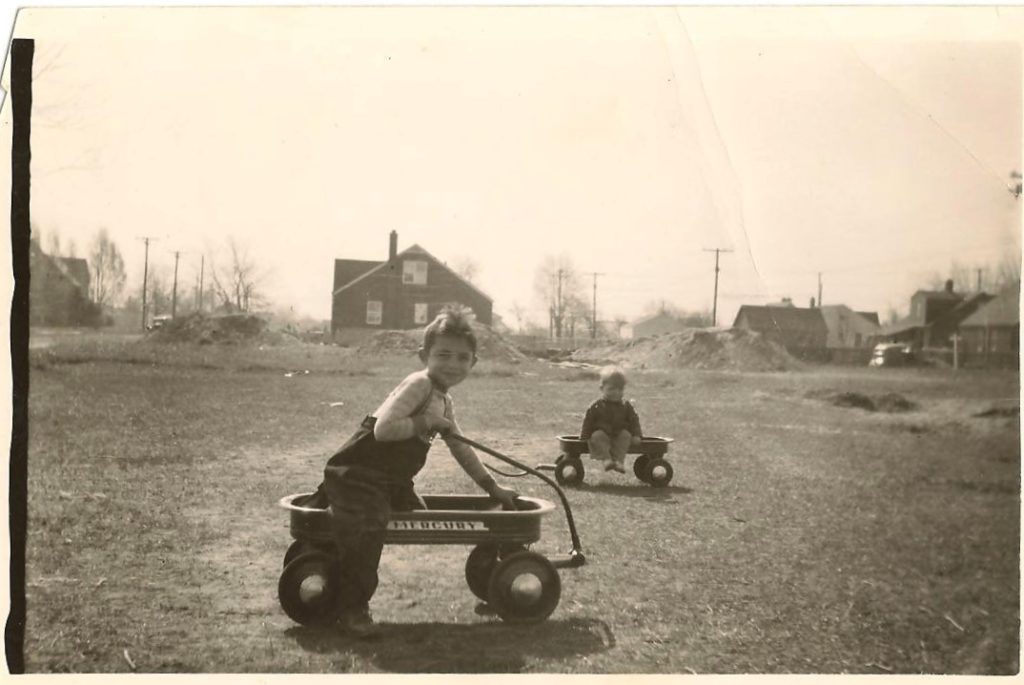
1956: Worked on an MARC (the predecessor to ARCA) late model stock car for the local Ford Dealer, and spent that summer traveling to race tracks throughout the Midwest as a full crew member. I had already decided I wanted to drive stock cars professionally as soon as I was old enough. During this time I lost my steady girlfriend due to my long absences. I did not want to give up girls for racing, so I decided in the future I would race closer to home, where I could take my new girlfriend with me. This concept converted me from oval track racing to drag racing, which I could do locally, there being nine drag strips within 4 hours of my hometown, East Detroit.
1957 to 1958 I joined the Tappet Tickers, a local Hot Rod Club, which together with other Hot Rod Clubs throughout Michigan formed the Michigan Hot Rod Association. (Connie Kalitta was a member of an associated club, the Bearing Burners from Mt. Clemens, and we were friends for many years) Michigan Hot Rod Association, through assessments to each member club, fund raising activities such as car shows, (Detroit Autorama) we bought farm property in nearby New Baltimore, Michigan. With mostly our volunteer labor, we built International Dragway, which was later sold to Gil Kohn and renamed Motor City Dragway. We opened the track in 1957, and I started to race my personal car, a 1956 Ford with a NASCAR dual quad kit in A/S. During this time, I meet Jack Gray, who was a car salesman at Bob Ford in Dearborn. Jack raced his new Ford demonstrators, which were always the lightest models with the biggest engines. Jack had a lot of Ford connections, and was provided the same special engine and powertrain components as used in NASCAR from Holman Moody. Jack’s cars were among the fastest in S/S, and could compete with the best of the Chevrolets, Pontiacs and MoPars of the day.
1959 to 1961 My girlfriend had become my wife, and as my family and responsibilities started growing, it was impractical to have our family car as the car I raced. Jack Gray asked me to sell my car and just work on his race cars. So, after work I would drive to Dearborn and work on them at the Dealership, and sometimes I would just drive them back home, often cruising Woodward to see if I could get some action. I was never defeated on the street in one of Jack’s hot demonstrators. By 1961, the cars became modified enough to make them impracticable to drive on the street, so we began flat towing them. Also by this time we were not only getting trick parts from Holman and Moody, but complete blueprinted NASCAR engines as well. In 1961 there were nine drag strips within 3 hours tow, and we raced several events each week. We sometimes traveled on weekends throughout the Tri-State area, defeating Joe Ruttman in his brother Troy’s factory-backed 409 Chevrolet in the final at the season’s last big regional event at Central Michigan Dragway.
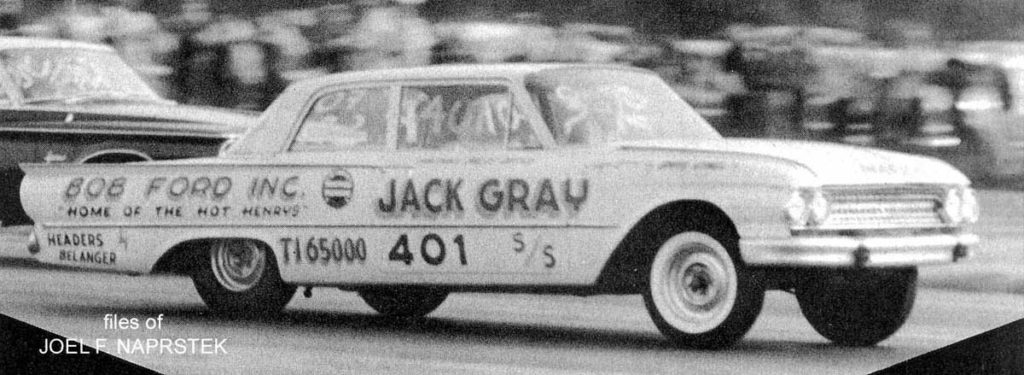
1962-1963 In 1962 Paul Harvey returned from Indianapolis to become the General Manager at Bob Ford. Paul was a big drag race fan and had good contacts inside Ford, so he elevated our racing effort from Jack Gray’s demonstrator to a full dealer-sponsored team with a new car and tow vehicle. Our 406 Galaxy was the fastest S/S Ford in Michigan, and at the Detroit Pre-National the weekend before Indy I defeated all the other Ford sponsored cars such as Gas Rhonda, Les Ritchey, Dick Brannon, and Phil Bonner. However, in the final with Frank Sanders Gil Kohn stopped us at the starting line just prior to staging to have a last-minute inspection for legality. Jack Gray took this opportunity to again ice down the intake manifold, after initially doing it in the staging lanes. The result was a too-cold intake manifold, stalling the engine at launch, giving the final to Frank Sanders after we consistently ran quicker times.
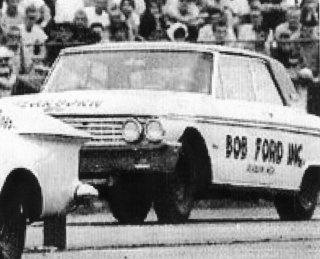
In 1963 Bob Ford was assigned two lightweight Galaxies, one of which I tuned and drove, the other tuned at Ford engineering as a test car, and which was driven by Len Richter and Bill Humphries. During the season I set the S/S MPH record, and was on my way to winning S/S at Indy when disqualified for shimming the front ball joints to correct the camber curve during launch. After Indy the Yellow car I drove was sold and I finished the season driving and tuning the Black Car, running an 11.70 ET, the quickest we ever ran in a full-sized ’63 Galaxy. At the end of 1963 I was hired direct by Ford Motor to work at their high performance engine dynamometer testing.
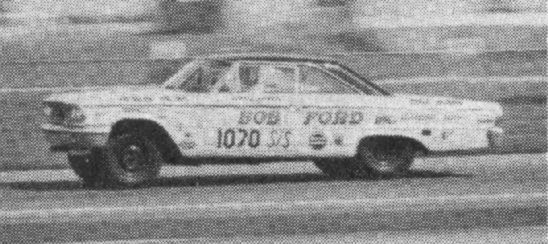
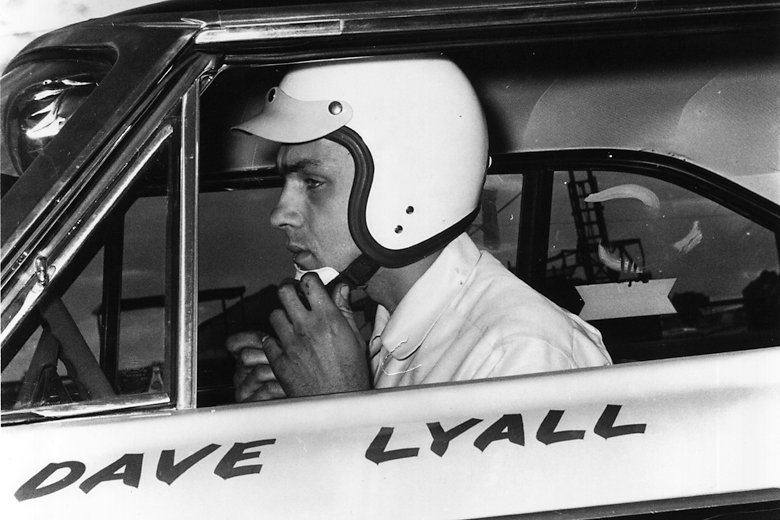
1964-1965 I, 1964 built and drove a 427 F100 in BFX during the ‘64 season at local Tracks and booked-in Match Races as far away as St. Thomas, Ontario, Canada. In 1965 I built and raced an AFX Falcon during the ‘65 season, again at both local Tracks and booked-in Match Races as far away as St. Thomas, Ontario, Canada. The sponsor for those years began having business issues, and wanted to cash-out, so the AFX Falcon was sold to the Catron Brothers, who rebuilt the car into more of a match race car.
Richard Petty went drag racing for about half the year in 1965. NASCAR put a rules change hurtin’ on the powerful hemi engine Richard used in 1964. As a result, Chrysler boycotted NASCAR and parked its factory-supported teams. Petty Enterprises raced to make money. While the company honored the factory boycott, Lee, Richard, Maurice, and Dale Inman still wanted to race and chose drag racing as the venue. 43Jr. ran series of drag events throughout the first part of 1965 – including the drag strip in Bristol, Tennessee. Petty Enterprises built a Plymouth Barracuda for Richard to run the NASCAR sanctioned event.
Before returning to the ovals, however, tragedy intervened for Petty at a drag strip in Dallas, Georgia on February 28, 1965. As the two cars green-lighted, Petty had problems, veered off the track, and plowed into some folks standing too near the strip. A young boy -8 year-old Wayne Dye – was killed.
1966-1967 It tuned and drove my old 427 Falcon in the NASCAR Drag Race Division in 1966 and built and drove a NASCAR Ultra Stock tube chassis 427 Fairlane with them for 1967. About half way through the season, one of the Catron Brothers was drafted, and the other brother wanted to cash out, so I bought them out of the Fairlane, and raced it for the rest of the 1967 season.
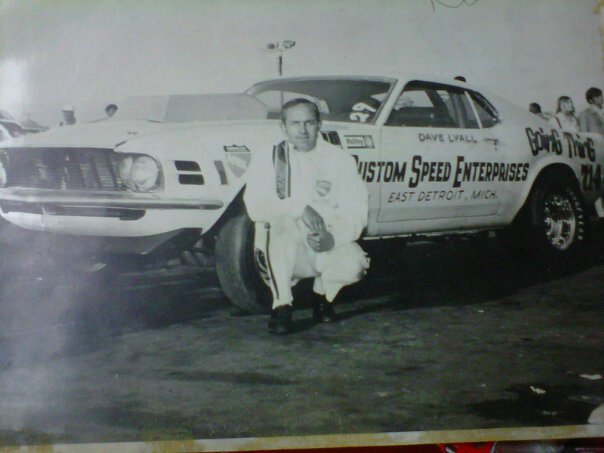
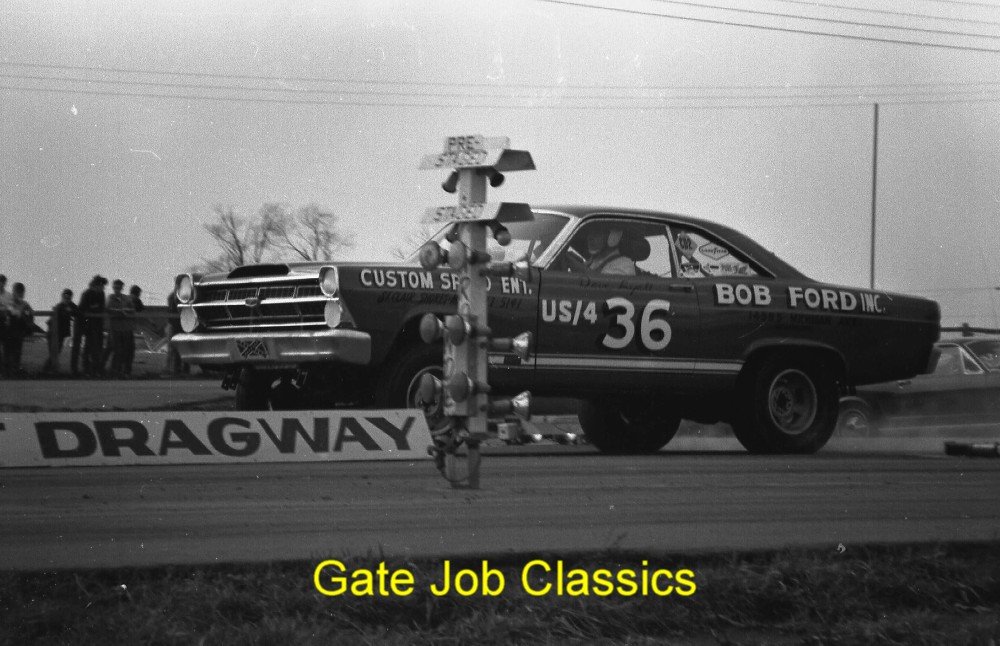
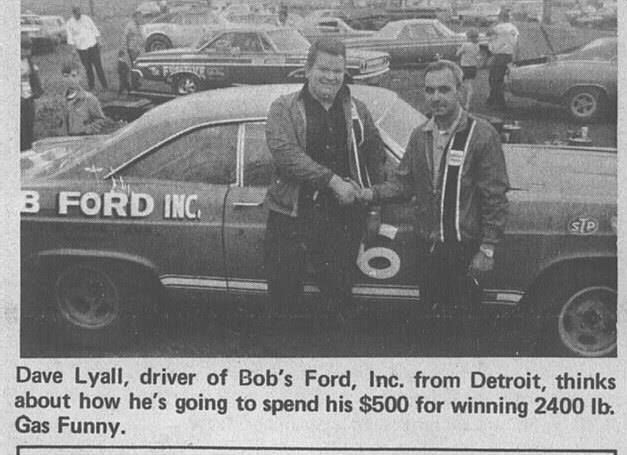
Engine on Hoist Picture – Dave’s “Going Thing” ‘69 Mustang being converted from 427 FE Tunnel Port power to the Boss 429 at Wayne Gapp’s Dearborn Racing Shop. L to R Wayne Gapp guiding the engine, the arms working the chain fall are mine, and guiding the engine on the right is the late Charlie Tennant, who was my race team mechanic from 1965 thru 1969, before he went with Pete Gate’s funny car team.
Engine Dyno picture was taken in a Ford Engineering Dyno cell around 1968, during development testing of the Ford Boss 429 Engine for NASCAR Racing. The people in the picture from left to right are: Dyno Test Technician Dave Lyall, Engineer John Brown, and Senior Boss 429 Program Engineer Wayne Gapp. Wayne and I were both friends and neighbors, and went on to do the Drag Race development on the Boss 429 in our personal drag race cars. Wayne and Jack Roush later partnered in what became the famously successful Gapp & Roush Race Team. The upper picture was taken in mid-1969 in Wayne Gapp’s Race Shop in Dearborn, were we are converting my 1969 Mustang Drag Car from the FE engine family 427 Tunnel Port, to the Boss 429 Engine. The persons in this picture are Senior Engineer Wayne Gapp on the left, hidden by the engine and operating the chain fall is Dave Lyall, and on the right is Ford Engine Build Specialist

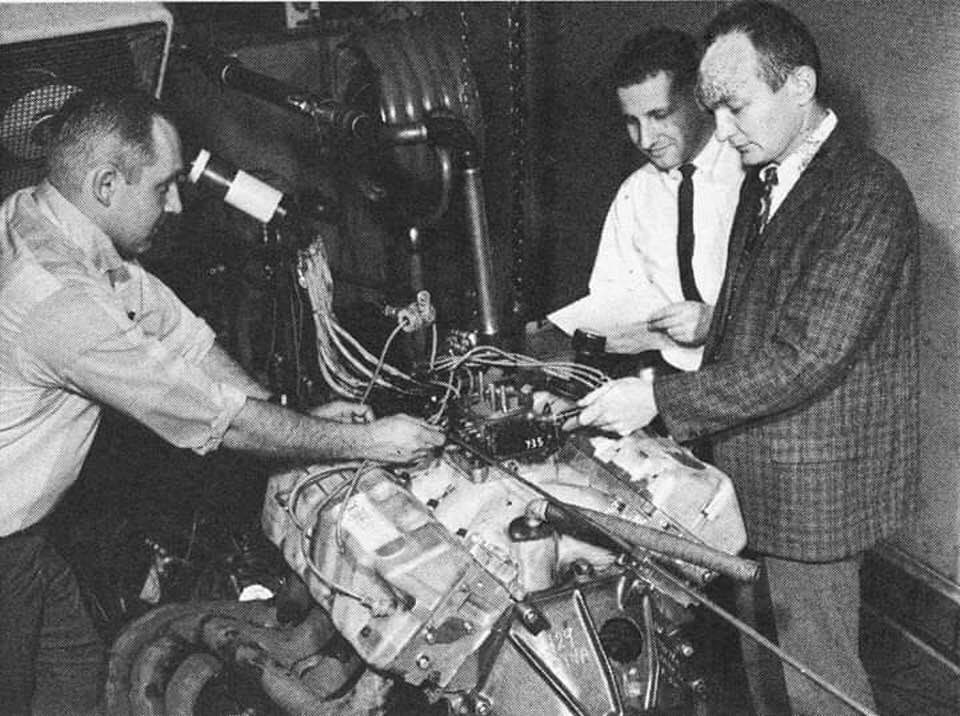
1968-1970 I built and drove a series of Mustangs, beginning with a factory special lightweight ‘68 Cobra Jet, which I campaigned in both NHRA and NASCAR, using different powertrains and hoods. A 428 CJ in NHRA and a 427 Tunnel Port in NASCAR. It was so much work changing the car from one association to the other, and the car was never optimized for either, I built two 69 Mustangs, one for each association, starting the year with 427 Tunnel Port engines, and finishing with Boss 429 Engines. At the AHRA Bristol Spring Nationals, I recorded the first 9 second run in Pro Stock. Rebuilt both cars into 1970 models for the 1970 season.
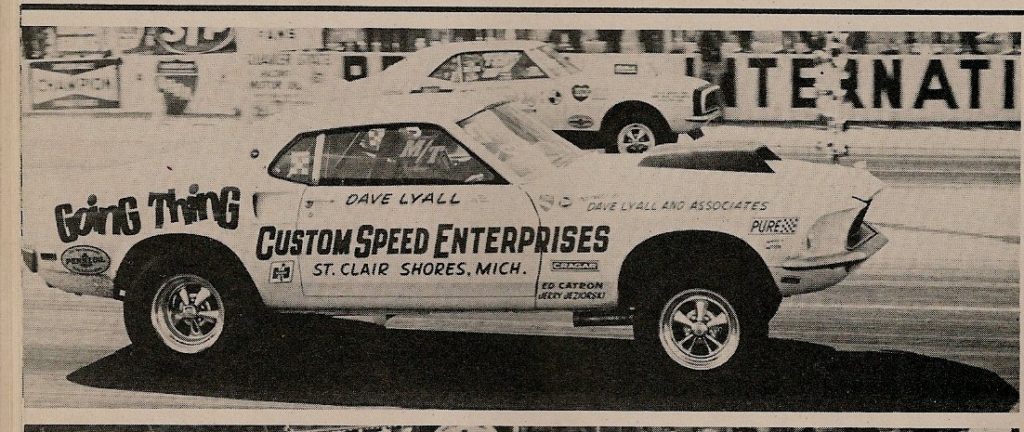

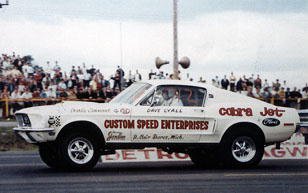
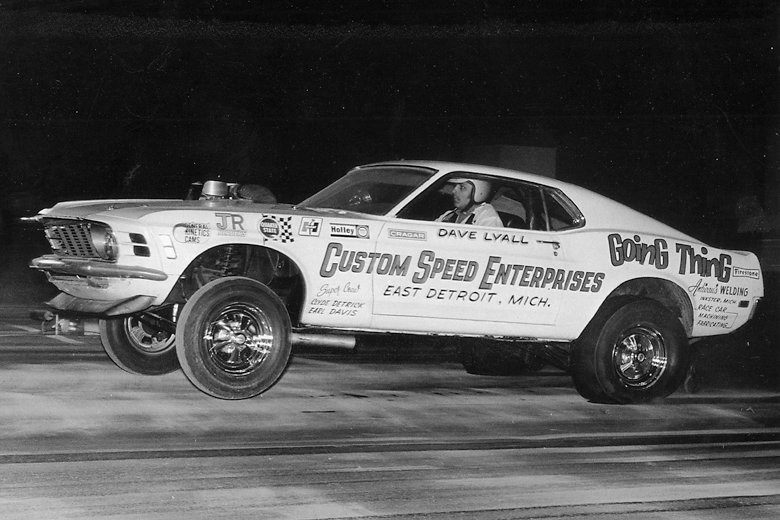
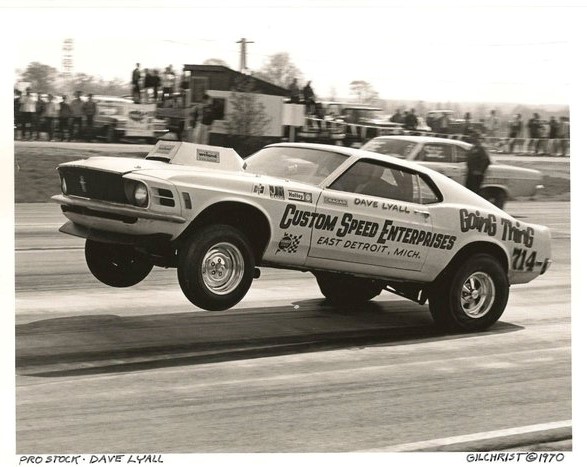
1971-1974 I Took 1971 off to open my own service station business, and in 1972 built a 1968 Mustang with Clyde Detrick to run local Detroit Area tracks, using a all-steel body, semi-tube frame, and a 427 Tunnel port engine, the car ran 10 seconds flat, before wrecking the car twice, the last time an end over backwards totaling the car. For 1973 and 1974, we built and raced a 351 Pinto Pro Stock car, which we campaigned regionally in the Midwest, running very low 9’s.
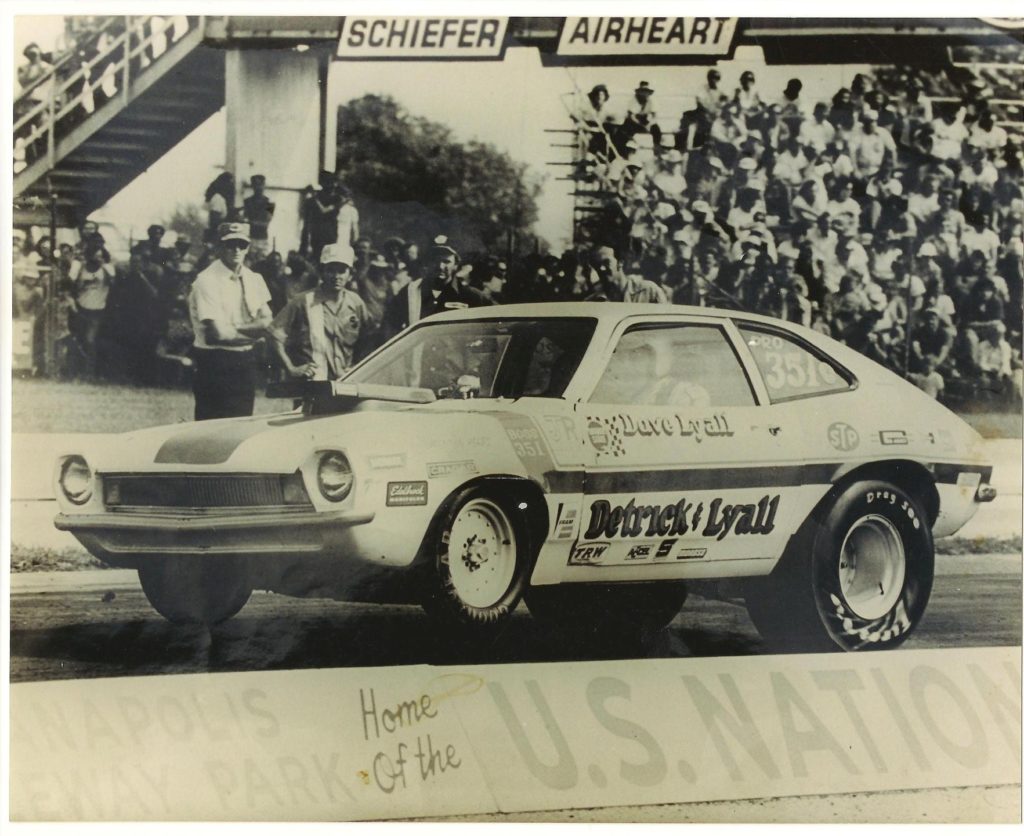
1975-1983 Retired from competitive driving, and began crewing for other racers such as my brother-in-law Carl Holbrook, and building, modifying and testing race cars for Holbrook’s business.
1984-1988 Worked for Jack Roush as Business Development Manager and special projects, such as PPG Indy Pace Cars, Cobra replicas, and established the Roush Special Vehicle Shop.
1989 I again drove and maintained a Ford big-block Tempo in IHRA Top Sportsman.
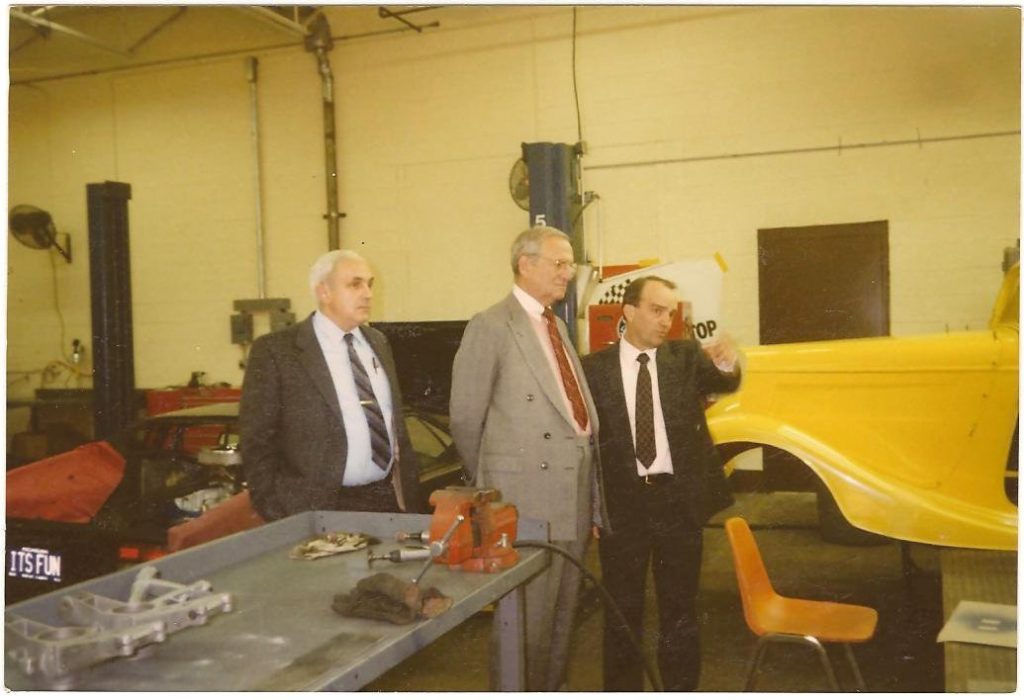
1990-1991 Continued working for Jack Roush on business development and special projects, such as PPG Indy Pace Cars, Cobra replicas, and worked with Stormin’ Norman to develop the Pro 5.0 Mustang Concept. During this time, I managed and drove the Storman Norman Pro 5.0 Mustang Drag Car, winning the Class Championship in 1991.
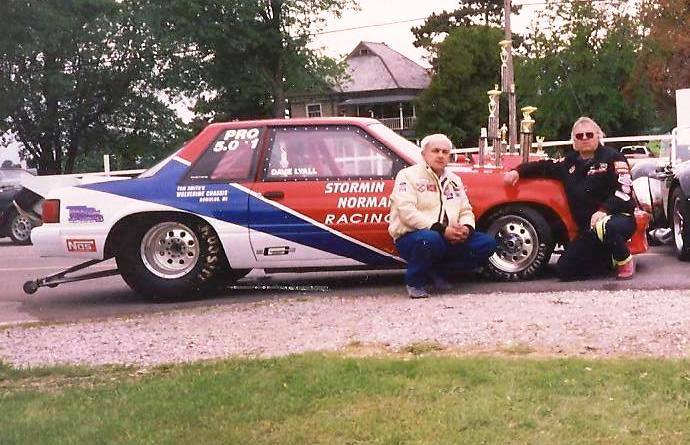
1992 While working at Roush, I was crew chief and again sometimes drove the Stormin’ Norman Pro 5.0 Mustang, setting numerous records and winning the “War to Settle the Score” special Mustang vs. Buick Grand-Am event at Englishtown Raceway driving the Stormin’ Norman Mustang.
1993-1999 I Raced with my brother-in-law Carl Holbrook, and his son, Chris Holbrook as a crewman on their Stu Evans Lincoln-Mercury Top Sportsman and Pro Stock efforts.
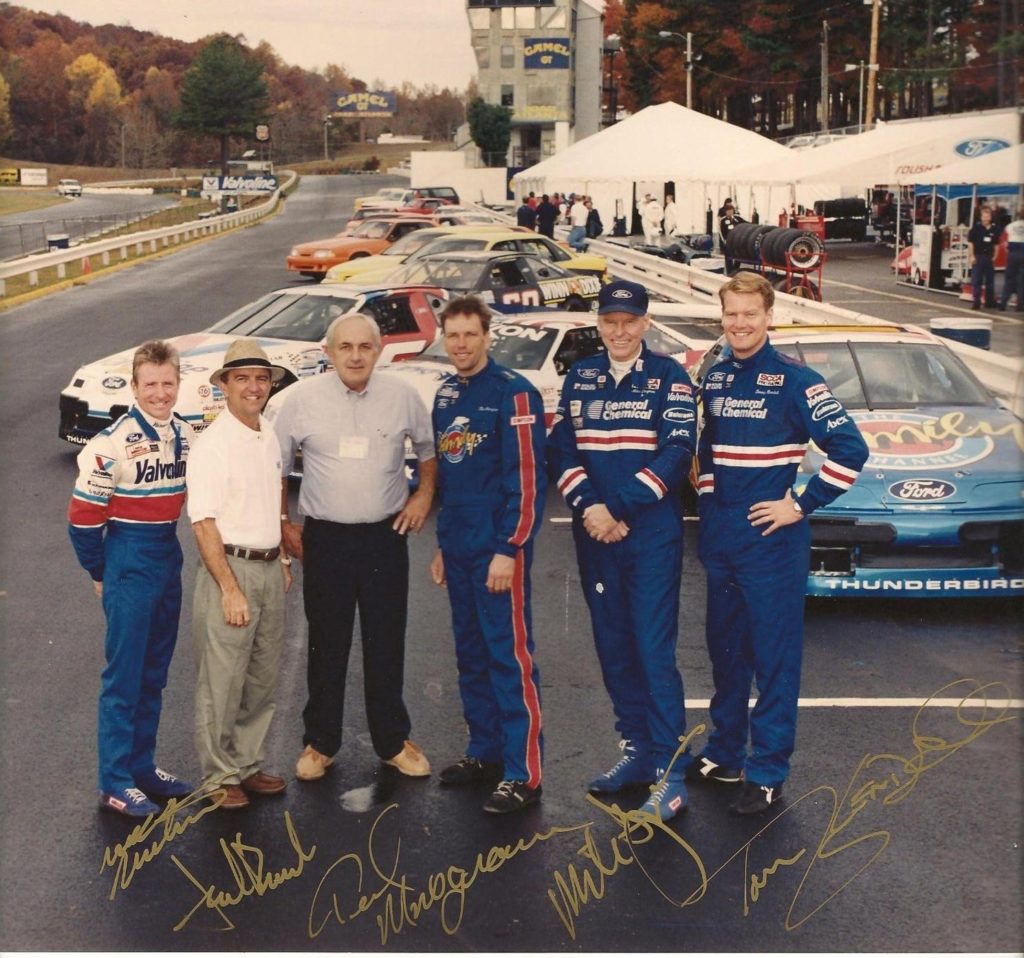
2000-2006 I bought the Ex-Stu Evans Lincoln-Mercury Top Sportsman Mustang, raced it in IHRA Pro Stock with Chris Holbrook. Then in 2000 I rebuilt it and as a Top Sportsman, racing it from 2001 to 2006, driving and maintaining the car myself.
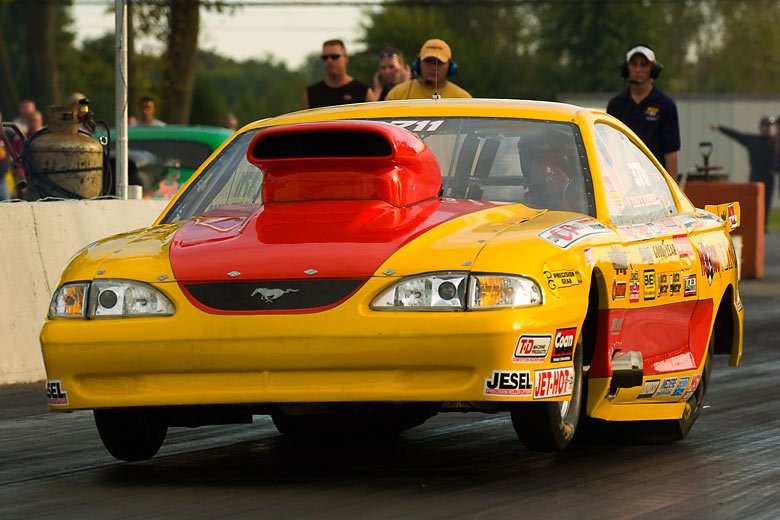
2007 I retired from racing at 67 years of age, selling my car, spare parts, truck and trailer, and ending a 50 year career as either a driver or crew chief in racing.
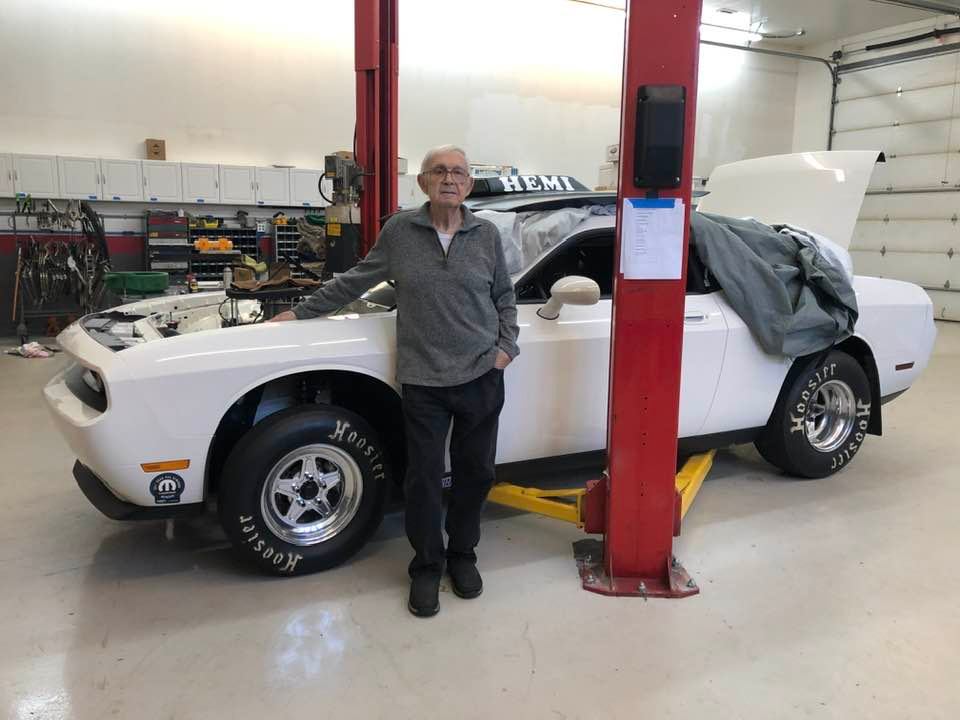

Great story Dave and I’d give you a good grade on the writing too! Xo Pat
Have always been very proud of my cousin Dave and his accomplishments. Jeff Lyall